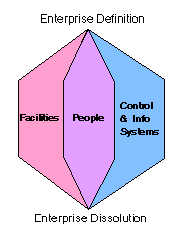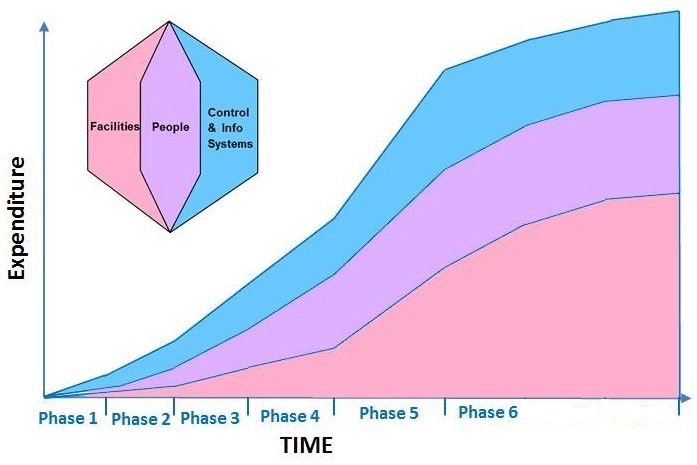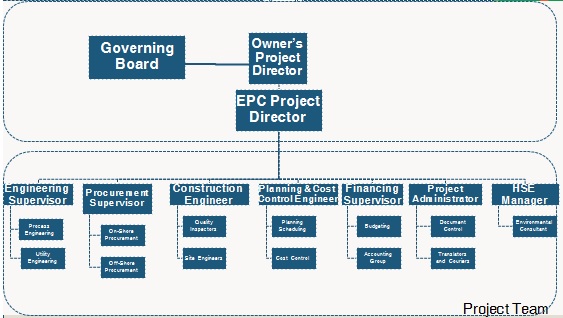What is a Human and Organization Architecture ?
 |
The Human and Organizational
Architecture is one of three basic components of any enterprise (the
other two are the Production Facilites, and the Control and Information
Systems Architectures.) In the PERA Model, it is usually depicted in the middle,
since -even more that the other two- it has interfaces with both the
"Control and Information Systems" and the "Facilities"of the
Enterprise.
The term "architecture", as used in this website, refers not only to bricks and mortar structures, but the structure via which material and data move through maufacturing facililites and organizations. |
The Organization develops during each phase
of the enterprise. Note that the development of the organization to
execute the project should be confused with the development of the
organization for the actual enterprise. The organization chart for the
enterprise is progressively developed during each successive phase up
to operations. The organization for the engineering, construction,
etc., are complete and may be disbanded at the end of each phase.

An example of a Project Organization chart for a large engineering project is as follows:

There are modelling systems such as ARIS, which are designed
to simulate both the Human and Organizational and Control and
Information Systems components of the enterprise during a given
enterprise phase (typically operations). Although these models can be
very valuable in that they model both the Human actions and Informaton
flows, however, these products do not model the production facility
itself, so considerable manual interface work must still be done if the
model is to correctly predict enterprise behavior.
FROM OTHER PAGE:
The Human and
Organizational Architecture may be
represented by a series of organization charts. An Organization Chart
defines the "positions" to be filled by people, and the flow of
authority through the hierarchy. This parallels the "equipment" and
material flows depicted by PFDs and MFDs in process and discrete
industries.
Development of Organizational design parallels physical
facility design. Historically, rigid, experience-based organizational
structures were the norm. For example, a Roman Legion (about 6000 men),
was organized into 10 cohorts, each cohort was commanded by 6
centurions, and each centurion commanded 100 men. This organization saw
little change during a thousand years.
The arrival of the industrial revolution brought accelerated
rates of change in all aspects of the enterprise. More flexible,
adaptable organizations were required to cope with these changes. New
organizations also required increased numbers of specialists with high
value skills who could no longer be treated as interchangeable
footsoldiers.
Most recently, flexible work teams, Quality Circles,
Outsourcing, and other innovations have fundamentally changed the rules
of enterprise organization. At the same time, group profit sharing,
personal development, and other new reward mechanisms are changing the
dynamic of the workplace.
In order to predict and optimize behavior of the Human and
Organizational component of the enterprise, modern modeling tools
simulate the effect of organization on enterprise performance, and even
model the flow of information across the interface between the "people"
component of the enterprise, and the information systems component.
As the enterprise evolves through each phase, different
organizational structure is required. Beginning with a very "high
level" Organization Chart during the Conceptual Engineering Phase, as
the enterprise design is developed during each successive phase, the
Organization Chart is elaborated to define increasing levels of detail
until eventually every position is defined (and budgeted). This process
is usually completed by the end of "Detail Engineering" of the
Production Facility.
Development of the Human and Organizational component of the
enterprise continues during the construction phase, until at startup,
each person in the organization has a position description, work
processes and procedures, reporting requirements, etc., and has been
trained in their roles and responsibilities. Work Flow Diagrams for
each Human task, as well as interfaces with the Control and Information
Systems and the Physical Production Facility are developed during this
phase. Modelling of these activities can be a powerful tool to optimize
the Human and Organizational Components of the enterprise, as well as
the Control and Information Systems and Physical Production Facilities.
by Gary Rathwell
© reserved
Back
to PERA Home Page


